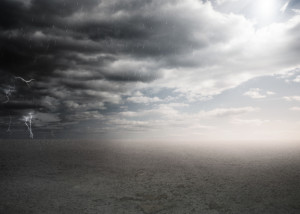Editor’s Note: David Legates, Ph.D., CCM, is the former Delaware state climatologist and director of the Center for Climatic Research at the University of Delaware, where he teaches. Legates received the 2015 Courage in Defense of Science Award at the Tenth International Conference on Climate Change, held on June 11 in Washington, DC.
The 2014 National Climate Assessment asserts extreme rainfall is increasing in the United States. Extreme rainfall in the past 30 years has occurred more often than in the early and middle portions of the 20th century, and according to climate models, the trend will continue in the future due to climate changes caused by increasing carbon dioxide concentrations.
Is extreme precipitation really more intense than it was 50 years ago? Plotting data from 1910 through 1992 shows near-zero slope exists, with an explained variance (R2) of only 0.007 percent! Plotting the data from 1995 to 2014 produces another insignificant slope with an R2 of 0.24 percent.
The data do not exhibit a trend, but rather show a discontinuity exists between 1992 and 1995. Since climate change usually exhibits a systematic change over time, not a sudden change, discontinuities are usually interpreted as resulting from a change in the measuring system, not a changing climate.
Change in Recording, Not Rainfall
What happened during the early 1990s to cause this discontinuity? In 1992, the National Weather Service (NWS) began a modernization program, completed in 1995. The Automated Surface Observing System (ASOS) changed the way NWS measured precipitation.
Historically, NWS employees measured precipitation using the standard “can-type” gauge, where observations are taken manually every hour. The NWS modernization program sought to provide near-real-time observations automatically. This resulted in the adoption of a “tipping-bucket” gauge (rain is funneled into small containers that tip back and forth, counted electronically as a specific rainfall amount) to replace the manual gauges.
Why did the NWS modernization program cause a discontinuity? Tipping buckets are known to underestimate rain during high-intensity events. The NWS applies a correction, increasing the observed rainfall by 15 percent when one-quarter of an inch of rain is measured in a minute, by 30 percent when a half an inch of rain is measured, and 45 percent when three-quarters of an inch of rain is measured. As this equation was most likely developed using data for light rainfall, these extrapolations may overcorrect for the bias and artificially inflate heavier rainfall events.
More importantly, the new gauges are equipped with an Alter windshield to minimize the deleterious effects of the wind. As wind speed increases, the rain caught by a precipitation gauge decreases. Although this under-measurement is greater for snowfall, the undercatch bias for rainfall can be as high as 6 percent. In particular, heavy rain events are likely to be concomitant with higher wind speeds. The use of a windshield decreases the undercatch bias and makes the gauge catch more efficient.
Finally, there is a further reduction in the undercatch bias resulting from the decrease in the elevation of the gauge orifice. The NWS can-type gauge is located about 30 inches to 48 inches above the ground, whereas the new NWS gauge is located much closer to the ground (about 18 inches). As wind speed increases with height above ground, the older gauges likely had more gauge under-catch bias due to the effect of orifice elevation.
The combined effect of an overcorrection for the tipping bucket bias, the adoption of an Alter windshield and reduced orifice elevation are responsible for an increase in the gauge catch efficiency. This explains the discontinuity at the point in the precipitation record where the new instrument was introduced.
Streamflow Is Not Increasing
Is this a plausible explanation? If extreme heavy rainfall is increasing, it stands to reason the extra water would have to go somewhere, and thus it should appear as an increase in the annual maximum streamflow. If annual maximum streamflow is indeed increasing or exhibits a discontinuity, this would be strong evidence the increase in heavy precipitation is indeed real. If streamflow is not increasing, that would lend credibility to the argument the increase in heavy precipitation is an artifact of the gauge measurement process.
To assess this, only non-urbanized and non-channelized basins must be considered, because any changes to land use, such as those caused by urbanization, or making the stream channel more efficacious will affect the flow.
Several studies have indeed investigated changes in such streamflow percentiles. In 1999, Harry Lins and James Slack concluded for streamflow in the United States in the 20th century, “[T]rends are … least prevalent in the annual maximum category.” More recently, R.M. Hirsch and K.R. Ryberg in 2012 examined whether the magnitude of floods in the United States had changed with increasing carbon dioxide levels. They found the annual maximum flood was not increasing and that flood magnitudes in the Southwest had actually decreased.
Bankfull streamflow is defined as the highest daily mean flow expected to occur, on average, once every 2.3 years. Bankfull streamflow data from the U.S. Geological Survey show no long-term trend in streamflow since 1950.
Greg McCabe and Dave Wolock in 2014 concluded annual maximum streamflow exhibited a mixed pattern with no monotonic trend.
The apparent increase in heavy precipitation events in the United States does not represent a climate change signal, but is instead an artifact created by the NWS modernization program in the early 1990s.
David Legates ([email protected]) is a climatologist with the University of Delaware.





